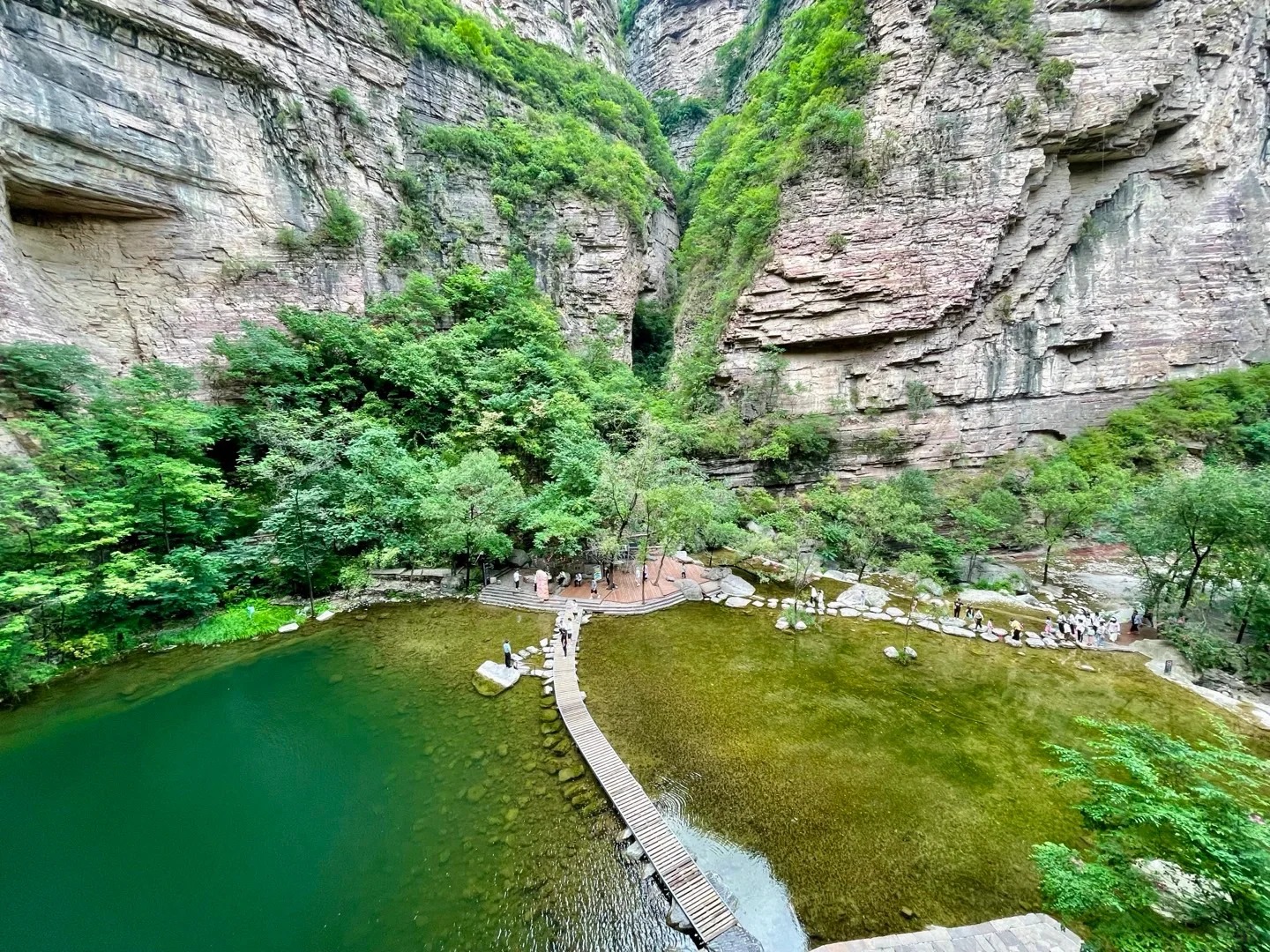Taihang Grand Canyon
Historical and Cultural Significance
The Taihang Grand Canyon has been a cradle of human civilization since ancient times, with traces of Neolithic settlements and historical relics scattered throughout the area. It served as a strategic military stronghold during the Warring States period and later inspired poets and artists with its awe-inspiring scenery. The canyon’s name, "Taihang," derives from the ancient Chinese term for "Great Barrier," reflecting its role as a natural divide between the North China Plain and the Loess Plateau. Cultural landmarks include ancient stone villages, temples, and inscriptions carved into cliffs, offering glimpses into the region’s storied past.
Geological Features
Formed during the Mesozoic and Cenozoic eras, the canyon’s landscape is dominated by red sandstone cliffs, limestone karst formations, and deep gorges. Key geological highlights include:
- Wangxiangyan Cliff: A 300-meter-high vertical rock face with layered sedimentary patterns.
- Taiji Ice Mountain: A seasonal phenomenon where ice remains frozen until late spring, creating a surreal Winter Wonderland.
- Dragon Lake: A serene alpine lake nestled amidst forested peaks, reflecting the surrounding cliffs.
The canyon’s dynamic ecosystem supports diverse flora and fauna, including rare plant species and migratory birds.
Major Attractions
- Wangxiangyan Scenic Area: The canyon’s most iconic section, featuring a glass skywalk suspended 1,080 meters above the valley floor, offering panoramic views of the red-rock cliffs and the winding Taihang River below.
- Taiji Ice Mountain: Explore ice caves and frozen waterfalls in winter, or hike through lush greenery in summer.
- Qingtian River Valley: Trek along a crystal-clear river flanked by towering cliffs, with opportunities for swimming and rock climbing.
- Tianlu Pass: A historic mountain pass with ancient stone steps and viewpoints overlooking the vast canyon.
- Zhuxian Town: A preserved traditional village with stone houses, temples, and local handicraft workshops.
Suggested Itineraries
- Half-Day Classic Route (3–4 hours):
- Start at Wangxiangyan → Walk the glass skywalk → Hike down to Qingtian River → Visit Zhuxian Town → Return via cable car.
Highlights: Skywalk thrills, river scenery, and cultural immersion.
- Start at Wangxiangyan → Walk the glass skywalk → Hike down to Qingtian River → Visit Zhuxian Town → Return via cable car.
- Full-Day Adventure Route (6–7 hours):
- Begin at Taiji Ice Mountain → Trek through Qingtian River Valley → Explore Tianlu Pass → Lunch at a local farmhouse → Visit Wangxiangyan’s cliffs and skywalk.
Highlights: Geological wonders, hiking challenges, and scenic diversity.
- Begin at Taiji Ice Mountain → Trek through Qingtian River Valley → Explore Tianlu Pass → Lunch at a local farmhouse → Visit Wangxiangyan’s cliffs and skywalk.
- Two-Day Comprehensive Tour:
- Day 1: Wangxiangyan Scenic Area → Qingtian River → Overnight in a canyon lodge.
- Day 2: Taiji Ice Mountain → Tianlu Pass → Zhuxian Town cultural experience.
Highlights: In-depth exploration of natural and cultural sites with relaxed pacing.
Ticket Purchase
- Online: Book via the official Taihang Grand Canyon website or travel platforms like Ctrip and Fliggy (up to 3 days in advance).
- On-Site: Purchase tickets at entrance gates (subject to availability; queues may be long during peak seasons).
- Prices:
- Peak Season (April–October): ¥160 (adults), ¥80 (students/seniors).
- Off-Season (November–March): ¥140 (adults), ¥70 (students/seniors).
- Free: Children under 1.2m, disabled visitors, and active military personnel.
- Included: Access to main scenic areas and shuttle buses between zones.
- Optional Add-Ons: Glass skywalk (¥60), cable car rides (¥40–80), and guided tours.
Transportation
- By Car/Taxi:
- From Anyang City: Drive 1.5 hours northeast via the G4 Expressway to the canyon’s south entrance.
- From Zhengzhou: A 3-hour drive north via the G55 Expressway.
- By Bus:
- Take a long-distance bus from Anyang Bus Station to Linzhou City (1 hour), then transfer to a local bus to the canyon (30 minutes).
- By Train:
- Nearest major station: Anyang Railway Station. From there, take a taxi or bus to the canyon (1.5–2 hours).
- Parking: Ample parking available at south and north entrances (¥10–20 per day).
Best Time to Visit & Tips
- Peak Seasons: Spring (April–May) and autumn (September–October) offer mild temperatures and vibrant foliage.
- Avoid Crowds: Visit on weekdays or early mornings; weekends and holidays can be crowded.
- Weather: Summer (June–August) is warm but rainy; winter (December–February) is cold but ideal for ice mountain views.
- Essentials:
- Wear sturdy hiking shoes (trails can be steep and rocky).
- Bring sunscreen, a hat, and layers for temperature changes.
- Stay hydrated; carry snacks or purchase food at designated areas.
- Photography allowed everywhere except in restricted cultural zones.
- Prohibited items: Drones, large backpacks, and open flames.
- Safety: Follow marked trails; avoid climbing unsecured cliffs. Check weather forecasts before visiting in rainy seasons.
Contact Us
What Our Clients Say?
Based on 10,000+ traveler reviews
















